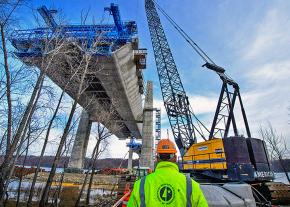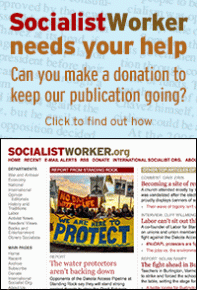An infrastructure plan to make companies drool
Trump's celebrated proposal to use tax credits to spur infrastructure development amounts to a massive corporate welfare program, explains .
DONALD TRUMP'S pledge to spend $1 trillion on infrastructure projects has fired the hopes of some progressives--such as Bernie Sanders--that the incoming Trump administration might do something positive to stimulate the U.S. economy and create jobs.
But there's much less to Trump's plan than meets the eye, even according to mainstream economists.
The issue, to be sure, isn't that America's infrastructure doesn't desperately need an upgrade. The estimated cost of repairs to existing U.S. infrastructure would cost three times what Trump proposes to spend.
But Trump's proposal to finance the program by using tax credits to forge partnerships between private corporations and government entities has a dismal track record.
THE DESTRUCTION caused by levee and floodwall failures in New Orleans during Hurricane Katrina in 2005 and the 2007 collapse of the Minneapolis Bridge are tragic reminders of the U.S.'s crumbling infrastructure. Critical infrastructure systems are aging and at risk of failure across the country, posing serious risks to the lives and health of the U.S. population.

Earlier this year, the American Road and Transportation Builders Association released a report rating 58,495 bridges in the U.S. as "structurally deficient." The American Society of Civil Engineers' latest "Report Card for America's Infrastructure" gave the U.S. system a cumulative grade of D+ and urgently called for spending $3.6 trillion on infrastructure projects by 2020.
Improving the infrastructure is only part of the goal, of course. Stimulating economic growth and creating more good-paying jobs are also stated aims of the infrastructure proposals of Trump and other politicians.
But everything about Trump's proposal is structured to create maximum gain and minimal risk for private investors and corporate construction giants, while doing precious little to make sure what gets built is what's actually needed.
Furthermore, it seems likely that taxpayers could end up getting whacked twice--first, by coughing up the financing for these projects, and second, by having to pay jacked-up tolls and fees or otherwise guaranteeing future profits to the corporations that want assurances regarding future returns on their investments.
What's more, Trump's plan opens the door for corporate giveaways, privatization and deregulation. As The Nation's Michelle Chen put it: "The goal isn't fixing bridges so much as fixing the corporate tax codes to promote privatization and unregulated construction with virtually no public input."
INSTEAD OF a traditional model of public infrastructure development in which the government borrows money by selling bonds and directly funds projects, Trump's plan would focus on "public-private partnerships" (PPPs), in which private investors are given incentives such as tax breaks, a level of control over the completed infrastructure (privatization) and the ability to make profits off it into the future.
PPPs are a neoliberal strategy to give big business a larger role in shaping government agendas while reducing the influence of the public on the process.
As David Harvey explains in his book A Brief History of Neoliberalism, PPPs emerged with the rise of neoliberalism as a way of structurally integrating state decision-making into the dynamics of market capitalism--to the detriment of democratic accountability. Through PPPs, the profit motive of business interests can influence public policy, determining what projects get approved based on the money that they will likely generate for private investors, often with little to no public oversight.
A private construction corporation thus might decide to build a bridge using publicly provided financing--in addition to locking in the right to get contracts to repair the bridge and to charge tolls to use it.
With interest rates at historic lows, it's a good time to borrow money for infrastructure projects, but Trump's proposal squanders that opportunity.
Considering that governments can borrow at much lower interest rates than private companies, using tax credits to help corporations secure financing is highly inefficient. In fact, as author Ellen Brown explains, roughly 50 percent of the cost of infrastructure is financing, and having the government directly finance these projects would not only give public officials greater control over what gets built, but the lower interest rates that the government qualifies for would cut costs in half.
The way that most PPP contracts are written also suppresses competitive bidding from smaller firms by only allowing large consortiums of firms to make bids on contracts, which often means higher bids and more expensive contracts.
After bidding high, these firms can then generate profits at later stages in the process by cutting corners and lowering wages. Trump's proposal seeks to facilitate this by pushing through deregulation and undermining prevailing wage standards.
Given allegations that Trump's renovation of Washington's historic Old Post Office violated federal law regarding wages, it's hardly surprising that his plan would aim to lower wages on these infrastructure projects.
The economic stimulus envisioned in Trump's proposal thus derives almost entirely from stimulating the bottom line of corporations, but not the bank accounts of working families.
TRUMP CLAIMS that his plan will boost economic growth in the U.S. by 4 percent. But this is sheer fantasy.
Since the 1990s, Japan's efforts to prime the pump of a sluggish economy have barely moved the needle. As Michael Boskin, a professor of economics who served as chair of the Council of Economic Advisers under President George H.W. Bush, argued:
Japan tried infrastructure-heavy serial fiscal stimuli for decades and is trying again under Prime Minister Shinzo Abe. Yes, Japan now has many new bridges, roads and paved drainage ditches, but the spending has done little to improve Japan's meager growth rate. What politicians in Japan or the U.S. don't mention is that government infrastructure projects tend to use massive, modern construction equipment, so they aren't labor intensive.
The highly mechanized nature of infrastructure projects means that investment in these types efforts generate fewer jobs than politicians claim--meaning less of the money will go directly to workers who are likely spend the money on essential goods and services, which could boost the economy.
But there are even more fundamental limits on the ability of a stimulus plan to yield long-term benefits for the economy. While public investment may bump up growth a bit, there has been very little correlation between government spending and growth in the U.S. since 2009.
"What really drives investment in modern capitalist economies, where private capital investment dominates, is the profitability of projects," according to Marxist economist Michael Roberts. "Private investment has failed to deliver because the profitability is too low."
Capitalism is in the throes of an economic crisis with low growth and investment rates, and no amount of government spending will solve this for the long run.
But even when considered in more narrow terms, Trump's plan may have only limited or no impact because of "capital shift"--the idea that private companies will simply delay already-planned infrastructure projects in order to seek financing through Trump's plan, resulting in no new net development.
THE TRUMP plan offers large tax breaks to private investors--to the tune of 82 percent of the equity amount of the project. The upside of this plan for conservatives is that it is "deficit neutral," meaning that it won't require new taxes or increase government debt--if one accepts the dubious economic logic of the architects of Trump's proposal.
But instead of taxes, people who rely on the infrastructure will likely have to pay user fees, such as tolls or higher utility rates, to the private companies that invested in the projects.
Residents of Chicago know firsthand about price gouging in the form of user fees. In 2008, then-Mayor Richard M. Daley inked a PPP deal with a subsidiary of banking giant Morgan Stanley to operate the city's parking meters. Since then, parking fees have been raised from 25 cents an hour to $2 an hour citywide and more than $6.50 an hour downtown.
Kevin DeGood, director of infrastructure policy at the Center for American Progress, explains how the Trump plan places the greatest share of the burden of funding infrastructure needs on working people:
[Trump's approach] amounts to a massive and unavoidable tax hike on middle-class Americans since infrastructure acts more like a monopoly than a competitive market. After all, only one pipe delivers water to your house, and most commuters have only one or two efficient routes to work. That means workers and families would be stuck paying the tolls and fees no matter what the rate.
Many PPPs stipulate "compensation events" or penalties that require governments to pay private investors if their revenues are threatened. This arrangement burdens the public with shouldering all of the risk, while private investors are free to reap all of the profits.
And if corporations find it hard to wring the necessary profit out of their investment, they can just sell their boondoggle back to the taxpayer and walk away. According to the Wall Street Journal:
A 2015 Congressional Budget Office report counted 14 completed highway projects that relied on some form of private financing. Of the eight that have been open for more than five years, half, including projects in Texas, California, and South Carolina, have either declared bankruptcy or experienced a public buyout of the private partners.
Because the profit motive is what drives investment decisions of PPPs, many critical projects with limited ability to generate revenue might not get funded under Trump's infrastructure plan. Low-income communities that may not be able to afford the user fees to make such projects viable might not see infrastructural improvements in their neighborhoods.
New York Times columnist and economist Paul Krugman makes another important point:
[H]ow is this scheme supposed to deal with infrastructure needs that can't be turned into profit centers? Our top priorities should include things like repairing levees and cleaning up hazardous waste; where's the revenue stream? Maybe the government can promise to pay fees in perpetuity, in effect "renting" the repaired levee or waterworks--but that makes it even clearer that we're basically engaged in a gratuitous handout to select investors.
At its core, Trump's infrastructure is a plan to make billionaire developers like him even richer--at taxpayer expense. It's shameful that Democratic politicians have already expressed their willingness to seek a bipartisan "compromise" with Trump regarding his infrastructure proposal.
If we want an infrastructure plan that will meet the needs of regular working people, we are going to have to fight Trump's push for deregulation, privatization and corporate welfare every step of the way.




